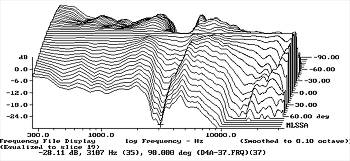| Columns Retired Columns & Blogs |
Dunlavy Audio Labs SC-IV/A loudspeaker Measurements part 2
John Dunlavy has always emphasized that the vertical spaced array nature of the drive-units in his designs means that the speaker's reference on-axis will not be achieved at distances closer than 8'. Unfortunately, the physical restrictions placed on my speaker measurements by Stereophile's listening/measuring room makes it impossible for me to make meaningful measurements much farther away than 50", which is why I have standardized this distance for the response measurements published in the magazine.
At this distance, the SC-IV/A looks reasonably flat, but with slight depressions in the lower and upper midrange and the presence region, and an excess of energy in the top two octaves. At this 50" mike distance, the mid-treble/high-treble balance was very dependent on the axis. Move the mike 1" above or below the tweeter and the top octaves were boosted by another couple of dB.
To investigate this distance-dependent nature of the Dunlavy's response, I measured the tweeter-axis response at 77" and 100". The two curves in fig.4 show the difference: indeed, the 100" response does have less HF energy than the 77" response. (Ignore the ripples in these curves, which are due to unavoidable room reflections and eyeball the mean level of the two curves.) It will be important, therefore, for SC-IV/A owners to ensure that they sit far enough away from the speaker for the drive-unit array to "focus" as intended.

Fig.4 Dunlavy SC-IV/A, anechoic response on tweeter axis at 77" (top) and 100" (bottom).
The changes in the Dunlavy's response with vertical axis (again at the 50" mike distance) are shown in fig.5. It looks as if moving much above or below the tweeter axis (which is a sensible 3' from the floor) emphasizes the mid-treble. However, in the lateral plane (fig.6), the SC-IV suffers from a relative lack of energy in the same region, which in a typical room will tend to equalize the reverberant field to be relatively flat. Other than in the mid-treble, the SC-IV/A's dispersion is well controlled, which will correlate with the good image precision noted by RD in his auditioning. Note the tweeter's somewhat restricted dispersion above 10kHz, which in very large rooms will lead to a lack of HF "air."

Fig.5 Dunlavy SC-IV/A, vertical response family at 50", normalized to response on tweeter axis, from back to front: differences in response 15 degrees-5 degrees above HF axis; reference response; differences in response 5 degrees-10 degrees below HF axis.

Fig.6 Dunlavy SC-IV/A, horizontal response family at 50", normalized to response on tweeter axis, from back to front: differences in response 90 degrees-5 degrees off-axis; reference response; differences in response 5 degrees-90 degrees off-axis.
- Log in or register to post comments




































